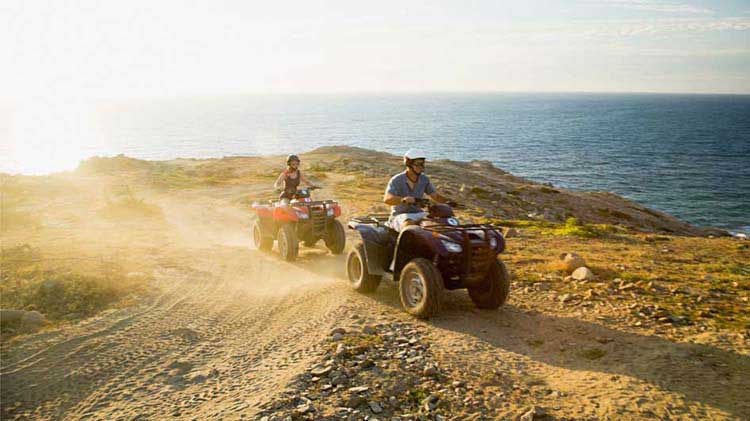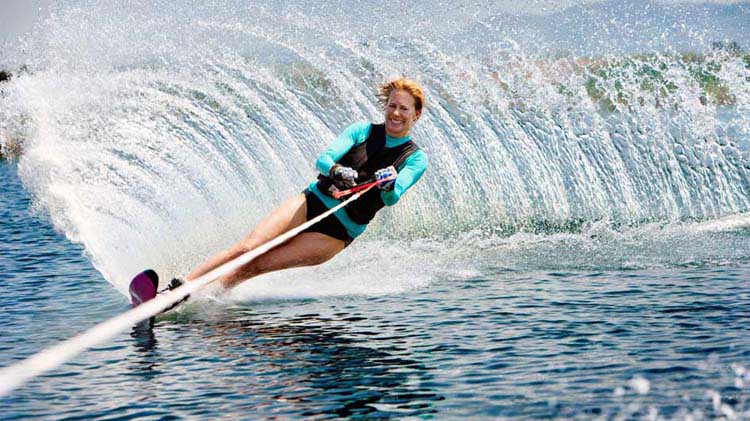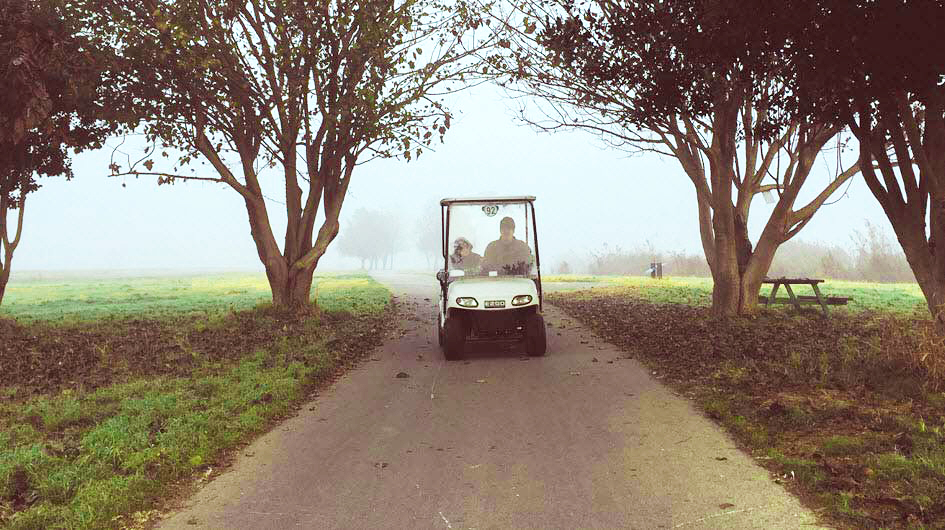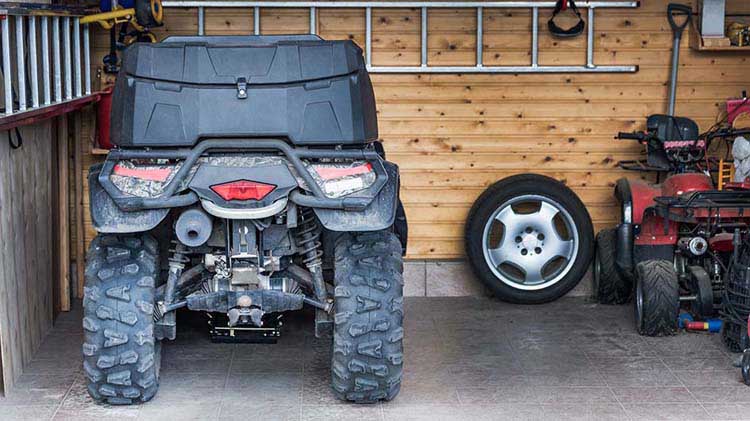ATV safety tips
Taking the proper ATV safety steps can help keep you and your family safe while you enjoy your riding experience.
All-terrain vehicles (ATVs) and off-highway vehicles (OHVs) such as dune buggies, side by sides and utility task vehicles (UTVs), can be a great way to have fun and enjoy the outdoors, but safely operating one requires proper instruction and preparation.
According to the U.S. Consumer Product Safety Commission (CPSC) per their 2024 report, ATVs caused a reported 1,728 fatal incidents from 2019 through 2021. Overturning and collisions with stationary objects or other vehicles were the major hazards resulting in these fatalities.
Whether doing daily chores around the farm or weekend trail rides, take the proper steps to be safer when using an ATV.
Before you head out on your ATV, UTV or side-by-side
Have an agent contact me
with a quote
- Always check local laws and regulations - off-road vehicle requirements vary by state.
- Consider an ATV training course - ATVs can travel more than 60 miles per hour and may tip over easily. Practicing basic techniques and knowing how to stay safe while riding one is recommended. Course topics typically include starting and stopping, quick turning, hill riding, emergency stopping and swerving and riding over obstacles. Some courses may also review information about ATV safety gear, local regulations, places to ride and environmental concerns. Visiting offroad-ed for online training and possible certification may be a good start. Some states require riders to complete an approved safety course and obtain an ATV license (ATV safety certificate).
- Wear protective gear that is weather-appropriate - this includes a Department of Transportation (DOT)-approved helmet, over-the-ankle boots, goggles, gloves, long pants and a long-sleeved shirt or jacket. This gear can help protect against possible cuts and other injuries. Having the right gear is important so that you will be warm or cool enough for the duration of the ride.
- Only ride with the designated number of people - many ATVs are designed for one person at a time. Carrying a passenger can make an ATV difficult to control and be very dangerous. Never carry more passengers than your ATV is designed for. Teens shouldn’t ride with a passenger, even if they have a multi-person ATV due to them being less experienced drivers.
- Maintain proper maintenance - a pre-ride checklist can help you double-check that your ATV is functioning properly. Check the fuel and oil, tires, brakes, steering, chain, radiator and battery.
- Leave a riding plan - let others know where you will be riding and how long you plan on being gone.
- Check your insurance and verify it's up-to-date - contact your local State Farm® agent if you have questions or need information about insuring your ATV, UTV, side-by-side or dune buggy.
Pack off-road essentials for your ride
If you're going to be riding long distances or all day, try to pack the essentials. If your ATV doesn't have a lot of storage, consider carrying a backpack. Some ideas on what items to take are listed below.
- Cell phone or walkie-talkie - carry a fully charged cell phone in case of an emergency, especially if riding alone. If you are in a remote area where cell service is limited, a walkie-talkie can be a good option. Put your communication devices in a waterproof bag to help protect them from water damage.
- First aid kit - injuries from any sport can happen, so it's a good idea to have a first aid kit on hand. Be prepared to treat minor injuries on the trail and know how to get help if you or another rider is hurt.
- Tire repair kit and an inflation device - don't let a flat tire keep you stranded. Bring an inflation device (as storage permits), whether it's an electric pump, manual pump or a CO2 inflator.
- Water and snacks - dehydration or any heat-related illness can be a big concern in warm climates, so fill up your water bottle before you head out. Riding offroad can take a lot of concentration and energy so healthy trail mix and bananas may be good options to help you replenish.
- Map - depending on where you ride, a simple low-tech map may help you find your way. Download maps of your riding area on your device so you can access them offline if needed.
- Lighter and/or matches - the ability to start a fire could be a lifesaver in an emergency or if you are stranded.
- Basic tools - some tools needed on the trail could include a basic tool kit and winch. A kit may contain a screwdriver with interchangeable bits, electrical tape, pliers and a wrench. A winch can help provide the pulling power you may need if a vehicle gets stuck in the terrain.
- Small jump pack in case of a dead battery - most ATVs today have an electric-start. In the event of a dead battery, a small battery pack can be used with cables to help jumpstart a machine and also provide added battery life for your cell phone.
On the trail with your ATV
- Become familiar with your riding trail - mapping out the trails where you'll be riding can help make your experience more enjoyable. Stepoutside.org provides some trail riding resources, such as maps and mobile apps.
- Ride at proper speed - ATVs can be unstable and difficult to maneuver when driven too fast for the conditions. To avoid flipping, maintain the proper speed for the terrain, especially on uneven ground. Also, be cautious of your speed when approaching hills, turns and obstacles.
- No tricks or stunts - these moves might look fun and easy on TV, but they are extremely dangerous.
- Avoid drugs and alcohol - they can greatly impair judgment and reaction time and may lead to a serious accident or injury.
- Stay off the pavement - ATVs are not intended to be driven on paved roads, except to cross them. They can be unstable and difficult to control at higher speeds and risk overturning and colliding with other vehicles on the road. The wide and low-pressure tires are designed to be driven on rough terrain only.
- Wear a seatbelt - some ATVs have seatbelts. If the vehicle has factory seatbelts, wear them while operating.
- Avoid riding in the dark - while most ATVs have headlights and rear lights, it is highly recommended that you ride only during the day so you can see your entire trail and surroundings. Riding in the dark can hinder visibility of the terrain and any wildlife.
ATV safety tips for kids
- Determine your child's readiness - operating an ATV requires the rider to recognize and react quickly to all sorts of potential hazards. Factors to consider include the physical, social, emotional and motor development of your child, as well as the ability to make sound decisions. The ATV Safety Institute has a readiness checklist to help you make an informed decision about your child's readiness. Having them complete an ATV safety course can allow the ATV rider to be more prepared for the trails and operate the vehicle properly.
- Educate yourself and your child - get proper training on how to safely operate an ATV. The resources on atvsafety.org may help you get started.
- Avoid letting children drive adult ATVs - driving an ATV requires speed adjustments, stable steering and the necessary balance to stay on the vehicle on rough terrain. Follow the manufacturer's minimum age recommendation.
- Closely supervise your child - children on ATVs should always be supervised to help ensure they are operating them safely. Always follow the manufacturer's minimum age recommendation for vehicle operation.
No matter your age, riding level or years of experience operating an ATV, be prepared and make safety a priority. You can check out the additional info we have on off-road vehicles, or if you're ready to get an insurance quote for your off-road vehicle, give us a few details and a State Farm® agent will reach out to you.
The information in this article was obtained from various sources not associated with State Farm® (including State Farm Mutual Automobile Insurance Company and its subsidiaries and affiliates). While we believe it to be reliable and accurate, we do not warrant the accuracy or reliability of the information. State Farm is not responsible for, and does not endorse or approve, either implicitly or explicitly, the content of any third party sites that might be hyperlinked from this page. The information is not intended to replace manuals, instructions or information provided by a manufacturer or the advice of a qualified professional, or to affect coverage under any applicable insurance policy. These suggestions are not a complete list of every loss control measure. State Farm makes no guarantees of results from use of this information.
State Farm Mutual Automobile Insurance Company
State Farm Indemnity Company
Bloomington, IL
State Farm County Mutual Insurance Company of Texas
Richardson, TX




